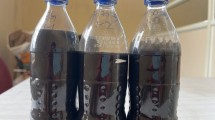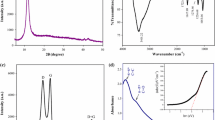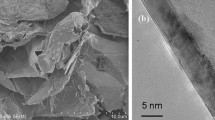Abstract
This study determined the optimal dispersion conditions of nanofluids by orthogonal experiments. Stable graphene/propylene glycol nanofluids are successfully prepared by a "two-step method" using a 60 wt % propylene glycol deionized water solution as the base fluid, and its thermal conductivity and viscosity are evaluated. Additionally, the effects of the graphene mass concentration and nanofluid temperature on thermal conductivity and viscosity are expounded, and a model for the prediction of thermophysical properties is established. The combined effect of thermal conductivity and viscosity on the heat transfer enhancement of nanofluids is analyzed theoretically, and the optimum mass concentration of graphene is determined. The results show that the thermal conductivity of nanofluids increases with the increase of the graphene concentration and nanofluid temperature. Also, the viscosity of nanofluid increases with the increase of the graphene concentration and decreases significantly with the increase of the nanofluid temperature. When the mass concentration of graphene is higher than 0.2 wt %, the increase in thermal conductivity caused by the increase of the graphene mass concentration decreases significantly, while the increase of viscosity increases significantly, and the effect of the heat transfer enhancement is almost not improved.













Similar content being viewed by others
Abbreviations
- C k :
-
Enhanced heat transfer coefficient
- \({C}_{p}\) :
-
Specific heat at constant pressure (J·kg−1·K−1)
- \({D}_{TCI}\) :
-
Stepwise increase in thermal conductivity (%)
- \({D}_{VI}\) :
-
Stepwise increase in viscosity (%)
- \(d\) :
-
Characteristic length (m)
- \(h\) :
-
Convective heat transfer coefficient (W·m−2·K−1)
- \({K}_{i}\) :
-
Sum of all absorbance values at the i level of a single factor
- \({k}_{i}\) :
-
Average value of each factor at all levels
- \(l\) :
-
Geometric Characteristic Length of Heat Transfer Surface (m)
- \(Nu\) :
-
Nusselt number
- \(Pr\) :
-
Prandtl number
- \(\text{R}\) :
-
Difference between the maximum value and the minimum value of \({k}_{i}\)
- PVP:
-
Polyvinylpyrrolidone
- \(Re\) :
-
Reynolds number
- TPS:
-
Transient plane source
- \(T\) :
-
Temperature (℃)
- \(TCI\) :
-
Average value of the increase of thermal conductivity (%)
- \(V\) :
-
Flow velocity (m·s−1)
- \(VI\) :
-
Average value of the increase of viscosity (%)
- \(w,\) :
-
Mass concentration of graphene (wt %)
- \(\mu \) :
-
Viscosity (mPa·s)
- \(\lambda \) :
-
Thermal conductivity (W·m−2·k−1)
- \(\rho \) :
-
Density (kg·m−3)
References
S.U.S. Choi, Enhancing thermal conductivity of fluids with nanoparticles. ASME Publ. Fed. 231, 99–106 (1995)
A.A. Balandin, S. Ghosh, W. Bao, I. Calizo, D. Teweldebrhan, F. Miao, C. Lau, Superior thermal conductivity of single-layer graphene. Nano. Lett. (2008). https://doi.org/10.1021/nl0731872
A. Arshad, M. Jabbal, Y. Yan, D. Reay, A review on graphene based nanofluids: preparation, characterization and applications. J. Mol. Liq. 279, 444–484 (2019)
A. Ghozatloo, M. Shariaty-Niasar, A.M. Rashidi, Preparation of nanofluids from functionalized Graphene by new alkaline method and study on the thermal conductivity and stability. Int. Commun. Heat. Mass. Transfer. (2013). https://doi.org/10.1016/j.icheatmasstransfer.2012.12.007
E. Sadeghinezhad, H. Togun, M. Mehrali, P.S. Nejad, S.T. Latibari, T. Abdulrazzaq, S.N. Kazi, H.S.C. Metselaar, An experimental and numerical investigation of heat transfer enhancement for graphene nanoplatelets nanofluids in turbulent flow conditions. Int. Commun. Heat. Mass. Transfer. (2015). https://doi.org/10.1016/j.ijheatmasstransfer.2014.10.006
T.T. Baby, S. Ramaprabhu, Enhanced convective heat transfer using graphene dispersed nanofluids. Nanoscale Res. Lett. (2011). https://doi.org/10.1186/1556-276X-6-289
W. Yu, H. Xie, D. Bao, Enhanced thermal conductivities of nanofluids containing graphene oxide nanosheets. Nanotechnology. (2010). https://doi.org/10.1088/0957-4484/21/5/055705
P. Dhar, M.H.D. Ansari, S.S. Gupta, V.M. Siva, T. Pradeep, A. Pattamatta, S.K. Das, Percolation network dynamicity and sheet dynamics governed viscous behavior of poly-dispersed graphene nano-sheet suspensions. J. Nanopart. Res. (2013). https://doi.org/10.1007/s11051-013-2095-2
M.B. Moghaddam, E.K. Goharshadi, M.H. Entezari, P. Nancarrow, Preparation, characterization, and rheological properties of graphene-glycerol nanofluids. Chem. Eng. J. (2013). https://doi.org/10.1016/j.cej.2013.07.006
D. Vasudevan, D. Senthilkumar, S. Surendhiran, Performance and Characterization Studies of Reduced Graphene Oxides Aqua Nanofluids for a Pool Boiling Surface. Int. J. Thermophys. (2020). https://doi.org/10.1007/s10765-020-02651-6
C. Liu, T. Zhang, B. Lv, Y. Qiao, Z. Rao, Preparation and thermo-physical properties of stable graphene/water nanofluids for thermal management. J. Mol. Liq. (2020). https://doi.org/10.1016/j.molliq.2020.114165
M.B. Moghaddam, E.K. Goharshadi, M.H. Entezari, P. Nancarrow, Preparation, characterization, and rheological properties of graphene–glycerol nanofluids. Chem. Eng. J. (2013). https://doi.org/10.1016/j.cej.2013.07.006
R.B. Ganvir, P.V. Walke, V.M. Kriplani, Heat transfer characteristics in nanofluid—A review. Renewable Sustainable Energy Rev. (2017). https://doi.org/10.1016/j.rser.2016.11.010
M. Gupta, V. Singh, R. Kumar, Z. Said, A review on thermophysical properties of nanofluids and heat transfer applications. Renew. Sustain. Energy Rev. (2017). https://doi.org/10.1016/j.rser.2017.02.073
T.G. Mayerhöfer, H. Mutschke, J. Popp, Employing theories far beyond their limits-the case of the (Boguer-) Beer-Lambert Law. ChemPhysChem (2016). https://doi.org/10.1002/cphc.201600114
Y. Yang, T.G. Voskuilen, T.L. Pourpoint, D.R. Guildenbecher, J.P. Gore, Determination of the thermal transport properties of ammonia borane and its thermolysis product (polyiminoborane) using the transient plane source technique. Int. J. Hydrog. Energy (2012). https://doi.org/10.1016/j.ijhydene.2011.12.011
S. Lagüela, P. Bison, F. Peron, P. Romagnoni, Thermal conductivity measurements on wood materials with transient plane source technique. Thermochim. Acta. (2015). https://doi.org/10.1016/j.tca.2014.11.021
S. Wang, Q. Ai, T. Zou, C. Sun, M. Xie, Analysis of radiation effect on thermal conductivity measurement of semi-transparent materials based on transient plane source method. Appl. Therm. Eng. (2020). https://doi.org/10.1016/j.applthermaleng.2020.115457
Q. Ai, Z. Hu, L. Wu, F. Sun, M. Xie, A single-sided method based on transient plane source technique for thermal conductivity measurement of liquids. Int. J. Heat Mass Transfer. (2017). https://doi.org/10.1016/j.ijheatmasstransfer.2017.03.008
W. Yu, H. Xie, X. Wang, X. Wang, Significant thermal conductivity enhancement for nanofluids containing graphene nanosheets. Phys. Lett. A. (2011). https://doi.org/10.1016/j.physleta.2011.01.040
F. Nasirzadehroshenin, H. Maddah, H. Sakhaeinia, Investigation of exergy of double-pipe heat exchanger using synthesized hybrid nanofluid developed by modeling. Int J Thermophys. (2019). https://doi.org/10.1007/s10765-019-2551-z
G. Çakmak, H.L. Yücel, Z. Argunhan, Experimental investigation of thermal performance in a concentric-tube heat exchanger with wavy inner pipe. Int. J. Thermophys. (2012). https://doi.org/10.1007/s10765-012-1210-4
P. Hu, W.L. Shan, F. Yu, Thermal Conductivity of AlN-Ethanol Nanofluids (J. Thermophys, Int, 2008). https://doi.org/10.1007/s10765-008-0529-3
Acknowledgements
This work was funded by National Natural Science Foundation of China [Grant No. 51406070], Projects of ‘Six talent peak’ of Jiangsu Province [Grant No. 2017-JSQC-008], and A Project of the Priority Academic Program Development of Jiangsu Higher Education Institutions.
Author information
Authors and Affiliations
Corresponding author
Additional information
Publisher's Note
Springer Nature remains neutral with regard to jurisdictional claims in published maps and institutional affiliations.
Rights and permissions
About this article
Cite this article
Dong, F., Wan, J., Feng, Y. et al. Experimental Study on Thermophysical Properties of Propylene Glycol-Based Graphene Nanofluids. Int J Thermophys 42, 46 (2021). https://doi.org/10.1007/s10765-021-02798-w
Received:
Accepted:
Published:
DOI: https://doi.org/10.1007/s10765-021-02798-w




